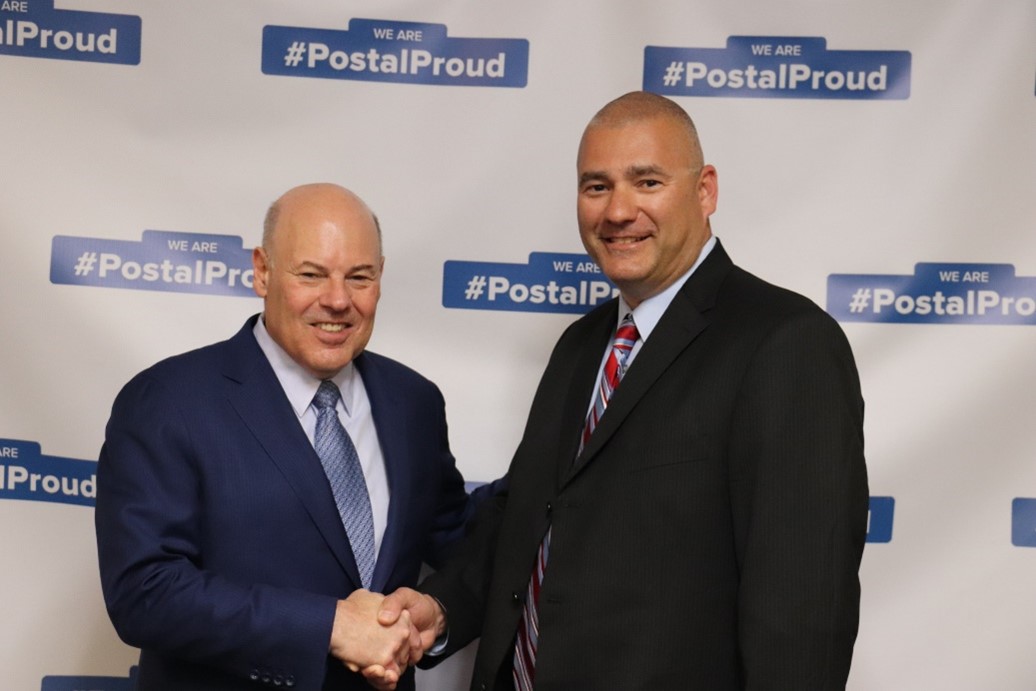March 21, 2022
Longmont, CO Postmaster installed on Wednesday, March 16, ceremony
Sean Schtakleff is the 10th Postmaster of Longmont since 1946

Postmaster General Louis DeJoy installed the new Longmont Postmaster Sean Schtakleff in a special installation ceremony on Wednesday March 16.
Sean Schtakleff was installed as Postmaster of Longmont, CO on Wednesday March 16, joined by family, friends and team members in a special ceremony. Postmaster General Louis DeJoy administered the Oath of Office to Schtakleff, alongside 29 other Postmasters throughout Colorado and Wyoming.
“It is a great honor to serve Longmont as your new Postmaster. In my 25 years with the United States Postal Service, I have seen firsthand the role the Postal Service plays connecting neighbors and our community to the nation. Our Post Office serves as a lifeline for our small businesses to reach customers no matter where they are.
“Under Postmaster General Louis DeJoy’s leadership and Delivering For America, the Postal Service’s 10-year plan, we are maintaining universal six-day mail delivery and expanded seven-day package delivery, stabilizing our workforce, and spurring innovation to meet the needs of our modern customers,” said Schtakleff.
-
The History of the Postmaster Position
Originally, the word Postmaster was referred as the one who provided post horses. According to the Oxford Dictionary, postmaster means “master of the posts, the officer who has charge or direction of the posts.”
William Penn established Pennsylvania’s first post office in 1683. However, the real beginnings of a postal system in the colonies dates from 1692 when Thomas Neale received a 21-year grant from the British Crown authorizing him to set up post roads in North America.
In 1707, the British Government bought the rights to the North American postal service, and, in 1710, consolidated the postal service into one establishment. The principal offices of the new British Postal Service were in London, England; Edinburgh Scotland; Dublin, Ireland, and New York.
In 1737, Benjamin Franklin was appointed Postmaster at Philadelphia. He laid out new post roads, helped expand mail service from Canada to New York and instituted overnight delivery between Philadelphia and New York City, a distance of 90 miles. In 1774, Franklin was dismissed from office in 1774 because of his efforts on behalf of the patriots.
When the Continental Congress met in May 1775, they named Franklin as postmaster general for the 13 American colonies.
From 1775 until the early 1800s, Postmasters were appointed by the postmaster general. In 1836, postmasters were appointed by the president, but this of course changed whenever a new party was elected. It was not until August 1970, with the signing of the Postal Reorganization Act, which to effect in July 1971, that the patronage system was finally removed from the postal service once and for all. Postmasters began being appointed on merit alone.
The act also permitted upward mobility for line employees, allowing them to be promoted to the position of Postmaster.
Along the way, there have been several famous individuals, who have served as postmasters. In 1833, Abraham Lincoln was appointed postmaster of New Salem, IL.
Other notable individuals who served as postmaster somewhere in the U.S. included abolitionist John Brown, businessman Conrad Hilton, novelist William Faulkner, and humorists Bill Nye and Mark Twain.
The Postal Service generally receives no tax dollars for operating expenses and relies on the sale of postage, products and services to fund its operations.
###
MEDIA ADVISORY
Media contacts
-
James Boxrud
James.N.Boxrud@usps.gov
970-278-6607
